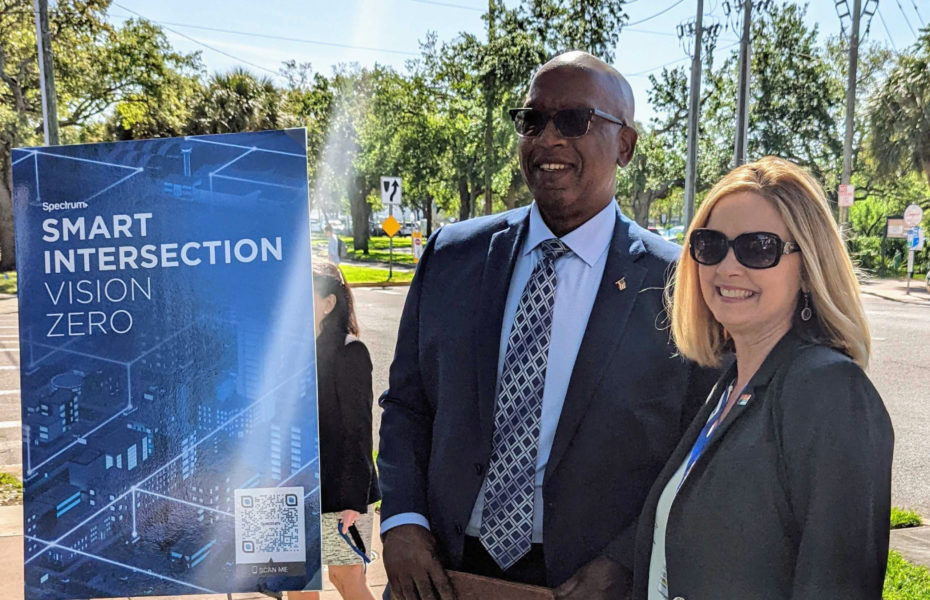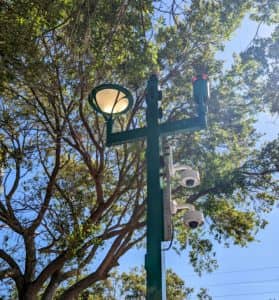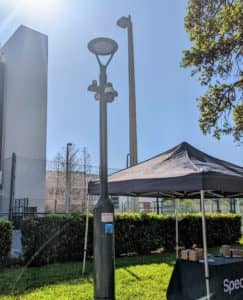Smart City Showcase highlights innovative problem-solving in St. Pete

Under the St. Petersburg Innovation District’s leadership, members of academia, local government, nonprofit organizations and the private sector are now utilizing new technology to help solve the city’s challenges.
During Tuesday’s Smart City Showcase, Innovation District members and partners demonstrated how the area is living up to its name. The event, held in the heart of the district at the University of South Florida St. Petersburg, provided the community with a hands-on opportunity to witness three pioneering projects in action. Attendees also heard how the data collected through the projects is helping make St. Pete a better – and more inclusive – place to live.
Several local leaders were on hand for the showcase, and they described how lessons learned from the innovative programs can shape future policy decisions in urban planning, workforce development and education in St. Petersburg.
“At the heart of all of our work has been the principle that we’re not doing this for the sake of technology,” said Alison Barlow, executive director of the Innovation District. “But because we want to solve problems and we want to enhance lives of people in the community.”
The groundbreaking projects, Barlow explained, are a direct result of two key partnerships. The first is with U.S. Ignite, a nonprofit based in Washington D.C. that supports cities across the country as they seek to leverage technology at the local level. Ignite awarded the Innovation District a grant three years ago to participate in its Smart City initiative.
The Innovation District then partnered with Spectrum Enterprise, which Barlow said provides the technical insights needed to make the projects possible. She said the district and Spectrum have worked side-by-side over the last three years to bring the Smart Intersection and Smart Lighting programs to fruition.

Smart Intersection technology continuously gathers real-time data to understand and analyze the movement of pedestrians and motorists, including accidents and near-misses at USFSP’s busiest intersection.
The intersection of 6th Avenue and 2nd Street South sits directly in front of what is considered the main entrance to the USFSP campus. Each day, hundreds of cars, students, busses, trolleys, bicyclists and pedestrians must navigate around each other at the busy junction. Campus police relayed a problem with accidents at the crossing, making it a prime location to build and test the Smart Intersection project.
“It was an intersection that we felt like we could learn a lot about, and we really wanted to understand what is happening,” said Barlow. “So, we worked with the city staff and said, ‘how do you understand an intersection?’”
Previously, Barlow said the city would pay an employee to manually tally what went through the intersection, either from the side of the road or by watching several hours of film at the office. The Smart Intersection technology now continuously gathers real-time data to understand and analyze the movement of pedestrians and motorists, including accidents and near-misses.
While two cameras track and collect data on everything in the area, Barlow said no personal information – including faces or license plates – is stored. An algorithm processes information across 36 different sets of rules, such as how fast and in what direction pedestrians and motorists are moving. It can also track multiple activities simultaneously, and artificial intelligence distinguishes between a person, bicycle or vehicle.
Collected data is then sent to the city so it can make better traffic management and redesign decisions.
Another highlight of the Smart City initiative is the Smart Lighting project. Barlow said the name is a misnomer, due to the many functions of the technologically advanced light poles. Internet connectivity allows the lights to save energy, adapt brightness and project different colors for alerts – all remotely controlled by operators.
The light poles also feature environmental sensors that track contaminants in a specific neighborhood, and that data is then compared to other areas and used to make informed policy decisions. After university officials told Barlow that the area around 6th Avenue and 3rd Street South was a security “dead zone,” the Innovation District focused on safety measures and outfitted the pole with cameras that feed directly to campus police.

The Smart Lighting project allows operators to remotely control brightness, issue warning, collect environment data and possess several safety features.
Barlow explained that during an event – a fireworks show, for example – operators can dim the lights in real-time when the show begins. When large groups of people return to their vehicles following the event, operators can then increase the brightness to promote safety. Barlow said the lights could even brighten or dim as people pass by.
The lights can also broadcast storm warnings and emergency information through mounted speakers and color-changing LED bulbs. Operators control the smart lights through a tablet, and Barlow said the current focus was tracking energy usage and environmental data.
The final project combines technology with hands-on learning and expertise from the USF College of Marine Science.
“I mentioned the conversation about community problems and challenges, and one of the things we talked about is the need for more STEAM education,” said Barlow.
The Guardians of the Gulf project is a pilot program that targets underserved youth in the area between the ages of 7 and 13. Kristen Kusek, program director, said the vision is a two-week summer program that spurs interest in marine science and creates better stewards of the environment.
The program’s primary partner is the Suncoast Boys and Girls Clubs, but Kusek said she hopes to create an entire community of guardians. Children help build artificial reefs equipped with underwater cameras and participate in other hands-on activities, but program organizers also utilize augmented reality games to teach and engage local kids.

Sarah Grasty, program manager for Guardians of the Gulf, shows the innovative augmented reality technology the organization uses to engage kids on the benefits of environmental responsibility.
Barlow said the program’s ultimate goal is taking the work and findings that emanate from the many marine research vessels located in the district and bringing the information to area children.
“It’s really kind of a neat way to think imaginatively on how you can take something that we all have an inclination should only be hands-on, but match it with technology tools.”







